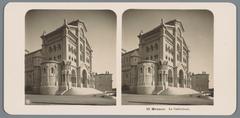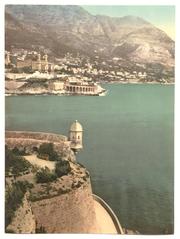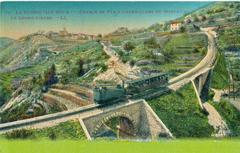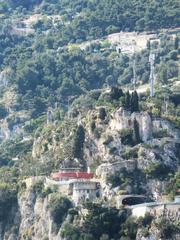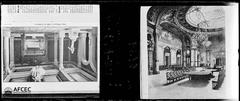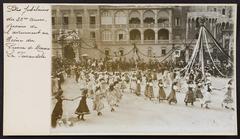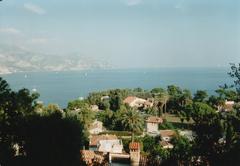
Musée de la Chapelle de la Visitation Monaco: Visiting Hours, Tickets, and Visitor Guide
Date: 04/07/2025
Introduction
The Musée de la Chapelle de la Visitation in Monaco is a testament to Baroque religious architecture and art, standing as one of the principality’s most significant historical and cultural sites. Originally built in the 17th century as a convent chapel for the Order of the Visitation of Holy Mary, this monument features a refined yet understated exterior contrasted by an opulent, art-filled interior. Noted for masterpieces by artists such as Peter Paul Rubens, Francisco de Zurbarán, and Jusepe de Ribera, the chapel has evolved from a spiritual sanctuary to a civic and cultural venue that continues to enrich Monaco’s heritage. This comprehensive guide outlines essential information on visiting hours, tickets, accessibility, and highlights, ensuring you make the most of your visit to this remarkable site.
Historical Background
Origins and Foundation
Commissioned in 1663 by Charlotte de Gramont, wife of Prince Louis I of Monaco, the Chapelle de la Visitation was constructed to serve the Order of the Visitation of Holy Mary. Its purpose was both spiritual and educational, providing guidance to young girls in Monaco and surrounding regions (visitmonaco.com). The Genoese architect Marc-Antoine Grigho infused the chapel with Baroque sensibility: its modest façade conceals a lavish interior adorned with decorative capitals and garlands, hallmarks of the period’s artistry (navaway.fr).
Evolution Through the Centuries
Over time, the chapel and its adjoining convent adapted to the principality’s changing societal needs. Beyond its original religious and educational functions, the complex was repurposed as a hospital, prison, and barracks. In 1910, Prince Albert I transformed the convent into the Lycée Albert Ier, Monaco’s principal high school, while the chapel continued to serve as a space for worship and public gatherings (visitmonaco.com).
Royal Significance
Following the demolition of the Church of Saint Nicholas in the late 19th century, the chapel became a temporary resting place for the remains of Monaco’s princes and princesses until the construction of the Cathedral of Our Lady Immaculate (fr.wikipedia.org). This cemented the chapel’s importance as a dynastic and national monument.
Artistic Heritage
In the late 20th century, the desacralized chapel became the Musée de la Chapelle de la Visitation, home to the prestigious Barbara Piasecka Johnson Collection. This collection included religious masterpieces by Rubens, Zurbarán, Ribera, and other Baroque luminaries, offering visitors a unique opportunity to view these works within their intended spiritual context (cityzeum.com; monte-carlo.mc). Grisaille apostles, liturgical objects, and textiles complemented the paintings, all displayed in an intimate, contemplative setting.
Restoration and Modern Use
In 2014, the Piasecka Johnson Collection was relocated, but the chapel remains a vital cultural venue, hosting temporary exhibitions, concerts, and special events. Recent renovations have uncovered well-preserved 18th-century frescoes, further enhancing the site’s artistic and historical value (fr.wikipedia.org).
Architectural and Artistic Highlights
Baroque Design
The chapel’s architecture reflects the grandeur and spiritual aspirations of the Baroque era. The façade, with its balanced symmetry and restrained ornamentation, gives way to an interior characterized by rich stucco work, gilded moldings, a single nave, and a beautifully decorated choir (visitmonaco.com). High-set windows filter natural light onto the sacred art, enhancing the contemplative atmosphere.
Artistic Masterpieces
The museum has displayed a collection of Baroque art, including:
- Paintings by Rubens, Zurbarán, and Ribera: These works exemplify Baroque drama and devotion, with chiaroscuro techniques and emotionally charged compositions (cityzeum.com).
- Altarpieces and Sculptures: Intricately carved, polychrome marble altars and wood or marble figures of saints and angels emphasize the union of artistic excellence and religious faith.
- Frescoes and Ceiling Paintings: 17th- and 18th-century frescoes adorn the choir, depicting scenes from the Virgin Mary’s life and other biblical stories (La Ferme Bleue).
Preservation Efforts
Monaco’s authorities have prioritized the preservation of the chapel, with major restorations undertaken to address structural issues and conserve the artworks. State-of-the-art conservation techniques have stabilized pigments, cleaned surfaces, and repaired historical features, ensuring the chapel’s integrity for future generations (La Ferme Bleue).
Visiting Information
Location and Access
The chapel is centrally located in Monaco-Ville on Rue de la Visitation, within walking distance of the Prince’s Palace and Monaco Cathedral. Monaco’s bus system (CAM) provides convenient access, and public parking is available at Parking des Pêcheurs nearby (Wanderlog).
Visiting Hours
- Standard Hours: Tuesday to Sunday, 10:00 AM to 6:00 PM
- Seasonal Variations: Hours may differ during exhibitions or special events; always verify on the official website.
Tickets and Admission
- Admission: Standard entry is approximately €6 for adults, with discounts for students, seniors, and groups. Children under 12 often enter free. Occasionally, admission is free for certain events or exhibitions.
- How to Buy Tickets: Tickets can be purchased on-site or online. Advance booking is recommended during peak seasons or special exhibitions.
Accessibility
- Mobility: The chapel is partially accessible; most public areas are at street level, but some interior steps and uneven floors may present challenges. Wheelchair users should contact the venue in advance for assistance.
- Facilities: Restrooms are available within or adjacent to the chapel. Audio guides and information panels are offered in multiple languages.
Visitor Tips
- Dress Code: Respectful attire is encouraged, particularly during religious services.
- Photography: Non-flash photography is generally allowed, but restrictions apply during concerts or for certain exhibits.
- Best Times to Visit: Early mornings or late afternoons are quieter. The chapel’s cool interior offers a refreshing retreat during summer.
Guided Tours and Events
Expert-led guided tours are available at scheduled times, providing in-depth insight into the chapel’s history and collections. The venue also hosts temporary exhibitions and concerts, especially during Monaco’s cultural festivals. Check the official events calendar for current programming.
Nearby Attractions
- Prince’s Palace of Monaco: The official residence of the princely family, featuring state apartments and palace guards.
- Cathedral of Our Lady Immaculate: Monaco’s main cathedral, final resting place of the Grimaldi princes.
- Oceanographic Museum: A world-renowned museum dedicated to marine science and exploration.
- Saint Nicholas Cathedral: Another important religious and architectural landmark.
Frequently Asked Questions (FAQ)
Q: What are the opening hours of the Chapelle de la Visitation?
A: Generally Tuesday to Sunday, 10:00 AM to 6:00 PM; check the official website for updates.
Q: How much are tickets?
A: Standard admission is approximately €6, with discounts for students and seniors. Certain events may offer free entry.
Q: Is the chapel accessible to wheelchair users?
A: The chapel is partially accessible; contact the venue in advance for assistance.
Q: Are guided tours available?
A: Yes, guided tours are offered at scheduled times, usually requiring advance booking.
Q: Can I take photographs inside?
A: Non-flash photography is allowed unless restricted for specific exhibitions or events.
Cultural Significance
The Chapelle de la Visitation is more than a historical monument; it is a living part of Monaco’s cultural and spiritual landscape. Its transformation from a convent chapel to a museum and event venue reflects the principality’s commitment to preserving its heritage while fostering contemporary creativity. The chapel’s integration into Monaco’s vibrant cultural calendar, especially during festivals and public celebrations, ensures its continued relevance and appeal (thecrazytourist.com).
Visuals and Digital Resources
For a richer visitor experience, explore high-quality photos and virtual tours available on the Monaco tourism website. These resources highlight the chapel’s architectural features, artworks, and panoramic views.
Summary and Recommendations
The Musée de la Chapelle de la Visitation stands at the crossroads of Monaco’s religious, artistic, and civic traditions. From its Baroque origins to its current role as a cultural hub, the chapel offers an immersive journey through centuries of history and art. Plan your visit by verifying current opening hours and ticket options, consider joining a guided tour, and take advantage of special exhibitions or concerts for a comprehensive experience.
For ongoing updates, event notifications, and guided content, download the Audiala app and follow Monaco’s cultural news on social media. Extend your exploration to other Monaco historical sites to fully appreciate the principality’s heritage.
Sources and Further Reading
- This guide draws on information from official tourism and heritage sources, including Monaco Tourism, Wanderlog, Wikipedia, Cityzeum, The Crazy Tourist, Monte-Carlo Tourism, and La Ferme Bleue.
For further details, consult:
- Monaco Tourism website
- Wanderlog’s guide
- Cityzeum
- The Crazy Tourist
- Monte-Carlo Tourism
- La Ferme Bleue

